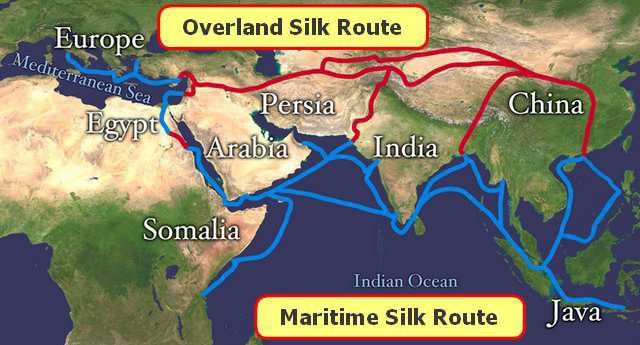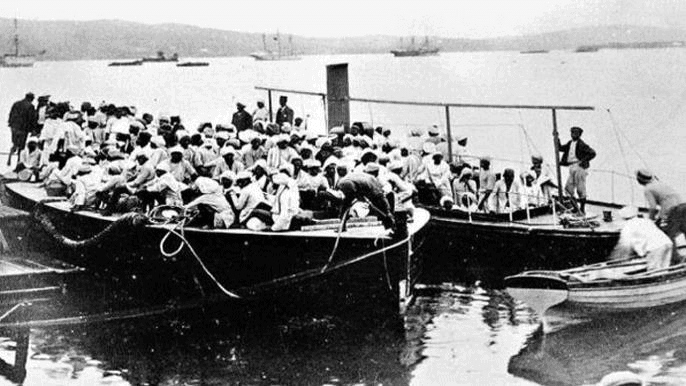Class 10 History Chapter 3 Question Answers - The Making of a Global World
Q1. How did the Silk Routes link distant regions in the pre‑modern world? Give two examples.
Ans. The Silk Routes comprised multiple overland and maritime paths that connected vast areas of Asia with Europe and North Africa, enabling long‑distance trade and cultural exchange.
- Example 1: Chinese silk moved westward, while gold and silver flowed from Europe to Asia along these routes.
- Example 2: Chinese pottery reached India, and textiles and spices from India and Southeast Asia circulated widely; Buddhism, Christian missionaries, and early Muslim preachers also travelled these routes
 Silk Route
Silk Route
Q2. Explain how food habits are good indicators of globalisation.
Ans. The exchange of food crops and habits between different regions and their adoption by different societies was a good indicator of globalisation.
Example: The Europeans benefited from the introduction of potatoes, with good for nutrients and health. Thousands perished in the 1840s during the Irish Potato Famine.
Q3. Who were the indentured labourers? Which states of India produced the largest number of indentured labourers?
Ans. Indentured labourers were bonded labourers who were transferable to any country on contract for a specific amount of wages and time. Most of the labourers were from Uttar Pradesh, Bihar, Central India and certain districts of Tamil Nadu.
 Indian Indentured Labourers
Indian Indentured Labourers
Q4. Describe some technological developments of the nineteenth century that affected industrial growth.
Ans. Railways were needed to link agricultural regions to the ports. Shipbuilding became an important industry and countries competed to control the trade routes on seas. The invention of the steam engine made it possible for steamships and railways to carry large volumes of trading materials over long and inaccessible distances.
Q5. What was the new system of slavery in the nineteenth century?
OR
Nineteenth-century indenture has been described as a new system of slavery. Explain any three points.
Ans. Nineteenth-century indenture has been described as a new system of slavery in the following ways:
- The poor labourers recruited as indentured labourers were often cheated by the agents and employers alike.
- Some were forcibly taken, while some were not even told of their final destinations.
- They were treated miserably. Such practices led some historians to refer to it as ‘a new system of slavery.’
Q6. How was the USA able to recover from the post–World War economic crisis?
Ans. The USA was able to recover from the post–World War economic crisis in the following way:
- The USA was able to recover from the post-war crisis at a great speed. Its economy resumed its strong growth in the early 1920s.
- An important factor was the introduction of mass production. Henry Ford, the owner of the Ford Company, was the first man to start using a new system of production, known as assembly line production.
- Others included large foreign investment and wartime loans as well as agricultural exports.
Q7. Describe how the Great Depression spread from the USA to other countries of the world.
Ans. The Great Depression spread from the USA to other countries of the world as follows:
- American crisis affected other countries in Europe and elsewhere by virtue of their being dependent on her overseas capital investment and loans. Then, their own internal weaknesses made the conditions worse.
- Many factors were responsible, including lack of confidence and panic among the investors.
- Britain also decided to return to the gold standard ratio of US dollar 4.86 to 1 pound sterling which was the pre-World War I level.
Q8. Briefly summarise the two lessons learned by the economists and politicians from the post-war economic experience.
Ans. In the post-war system two lessons learned by economists and politicians were:
- One was to ensure mass consumption in an industrial society by high and stable income.
- Another one was to ensure full employment and government control of flows of goods, capital and labour.
Therefore, they aimed to establish a stable economy and provide full employment in the industrial nations through the Bretton Woods institutions, namely, the IMF and the World Bank.
Q9. How did the Silk Routes link the world? Explain with three suitable examples.
OR
Explain any three characteristics of the Silk Route.
Ans. Pre-modern trade and cultural links between distant places were established by the Silk Routes.
- The Silk Route linked the West and China as silk cargoes were carried along this route. Historians have mentioned and identified several silk routes over land and by sea, which brought together vast areas of Asia and linked Asia with Europe and Northern Africa.
- Chinese pottery travelled to India through these routes, even before the Christian era, and textiles and spices from India and South-East Asia; precious metals, like gold and silver, flowed from Europe to Asia.
- Trade and cultural exchange took place at the same time. Buddhism emerged from eastern India and spread in several directions through the silk route. Christian missionaries travelled through these routes to Asia, as did the early Muslim preachers a few centuries later.
Q10. “The First World War was fought between two power blocs.” Explain.
Ans: The First World War was fought from 1914 – 1918. On the one side were the Allies – Britain. France and Russia (later joined by the US): and on the opposite side were the Central Powers – Germany. Austria–Hungary and Ottoman Turkey.
Q11. Describe in a few words how Europe changed at the end of the eighteenth century.
Ans. By the end of the 1700s, new scientific and revolutionary ideas changed how Europeans thought and acted. The Industrial Revolution started in England and spread to other European countries. The Reformation, led by Martin Luther, boosted capitalism and scientific thinking.
Q12. Write a short note on the effects of the Second World War.
Ans. The effects of the Second World War are as follows:
- The Second World War was more devastating than the first. About 3% of the world’s population perished; more civilians died than the fighting soldiers.
- Two crucial developments shaped the post-war scenario of which the first one was the emergence of the USA and the USSR as superpowers.
- The second was the establishment of international organisations like the UNO and others to maintain peace and stability.
|
88 videos|630 docs|79 tests
|
FAQs on Class 10 History Chapter 3 Question Answers - The Making of a Global World
| 1. What are the key factors that led to the making of a global world? |  |
| 2. How did colonialism influence the global economy? |  |
| 3. What impact did the Industrial Revolution have on global trade? |  |
| 4. How do cultural exchanges contribute to globalization? |  |
| 5. What challenges arise from a globalized world? |  |

















